Two days ago I spent an hour and 45 minutes attempting to photograph a male Marsh Wren building one of his “dummy” nests at Bear River MBR. I know he was a male because only males sing and this fella was an enthusiastic and glorious singer. I’m quite confident the nest was a dummy nest rather than the one that will eventually be used for brooding eggs for reasons I’ll get into later.
Like all Marsh Wrens he was a very difficult subject to photograph well. These birds are small and they’re extremely fast. Throw in their preferred habitat of dense cattail and bulrush marshes and you have a very difficult bird to get a clear shot of.
All of the following images are of the same male and I’m presenting them in the order they were taken in order to provide the reader a sense of the process of nest-building. That said, we never do see the actual nest because it was buried in a thick mass of cattails.
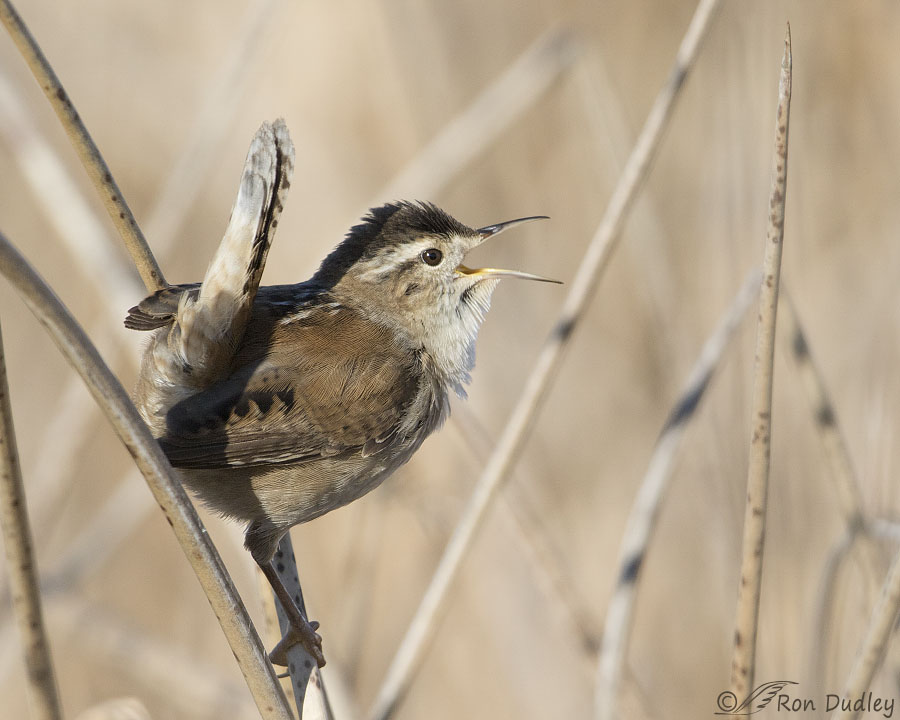
1/2000, f/6.3, ISO 500, Canon 7D Mark II, Canon EF 500mm f/4L IS II USM + EF 1.4 III Extender, not baited, set up or called in
I barely spotted this bird in the cattails far behind me and then backed up my pickup to see if he’d stick around. Unlike most wrens he did. He did quite a bit of singing soon after I arrived but after a while he spent the vast majority of his time constructing the nest and significantly less of it in melodic pursuits. That fact made me wonder if his initial singing was a specific territorial defense directed at me and my pickup but he soon got used to my presence and seemed to completely ignore me.
As I mentioned, only males sing. Interestingly, when captive females are given supplemental testosterone they can produce a laborious series of “buzzes” but nothing resembling the song of the male.
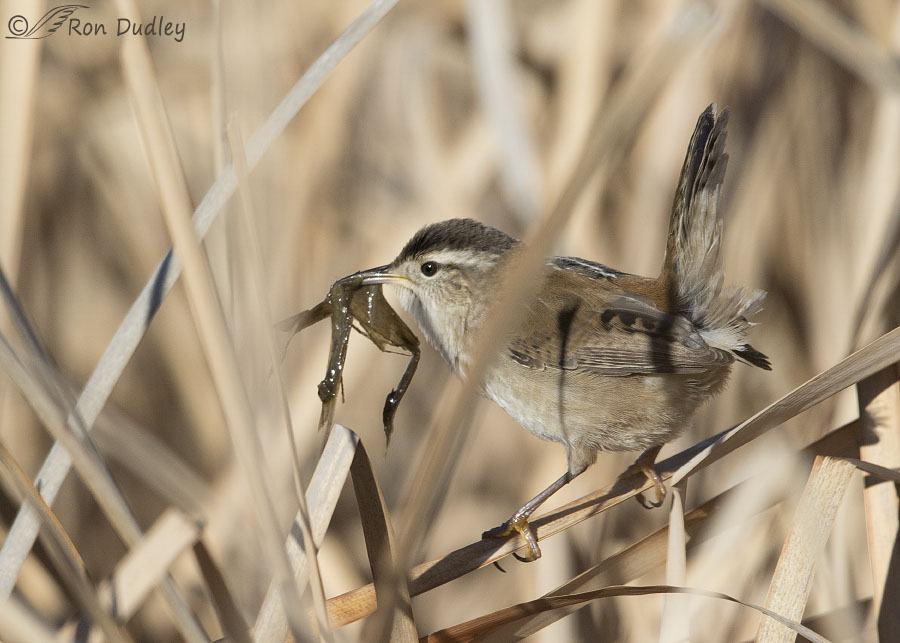
1/3200, f/6.3, ISO 500, Canon 7D Mark II, Canon EF 500mm f/4L IS II USM + EF 1.4 III Extender, not baited, set up or called in
His preferred nesting material was pieces of last year’s cattail leaves and they were always wet. They prefer them wet because that makes them soft, pliable and easier to weave into their nest (human basket weavers often use wet materials for the same reason).
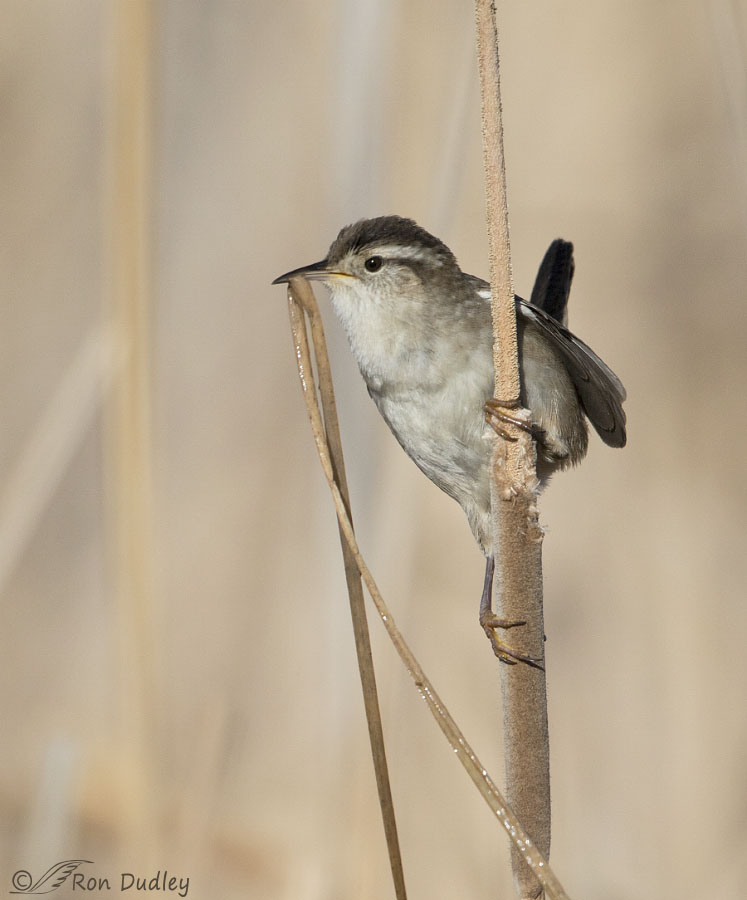
1/5000, f/6.3, ISO 500, Canon 7D Mark II, Canon EF 500mm f/4L IS II USM + EF 1.4 III Extender, not baited, set up or called in
His chosen construction materials varied significantly in overall size and length. This one was so long I couldn’t keep it all in frame. When he took off toward the nest with it I tried to photograph him in flight.
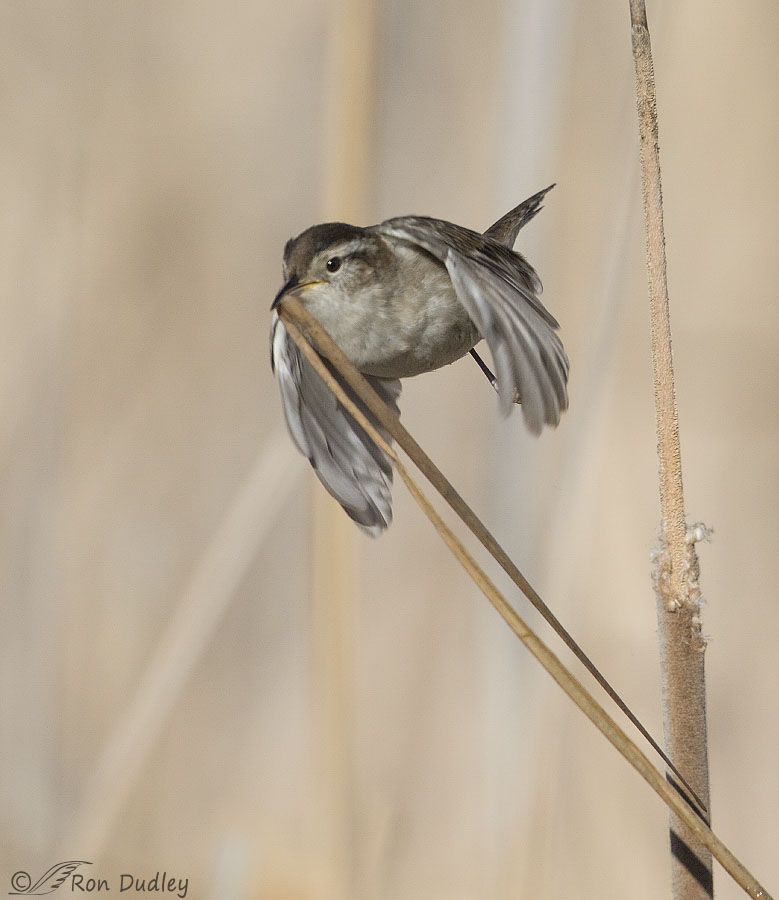
1/5000, f/6.3, ISO 500, Canon 7D Mark II, Canon EF 500mm f/4L IS II USM + EF 1.4 III Extender, not baited, set up or called in
But even when carrying a load that slowed him down a little he was so fast that I didn’t get him quite sharp. I thought it was a bit of a victory just keeping him in frame without clipping any body parts although I had no chance at all of avoiding cutting off part of the nesting material.
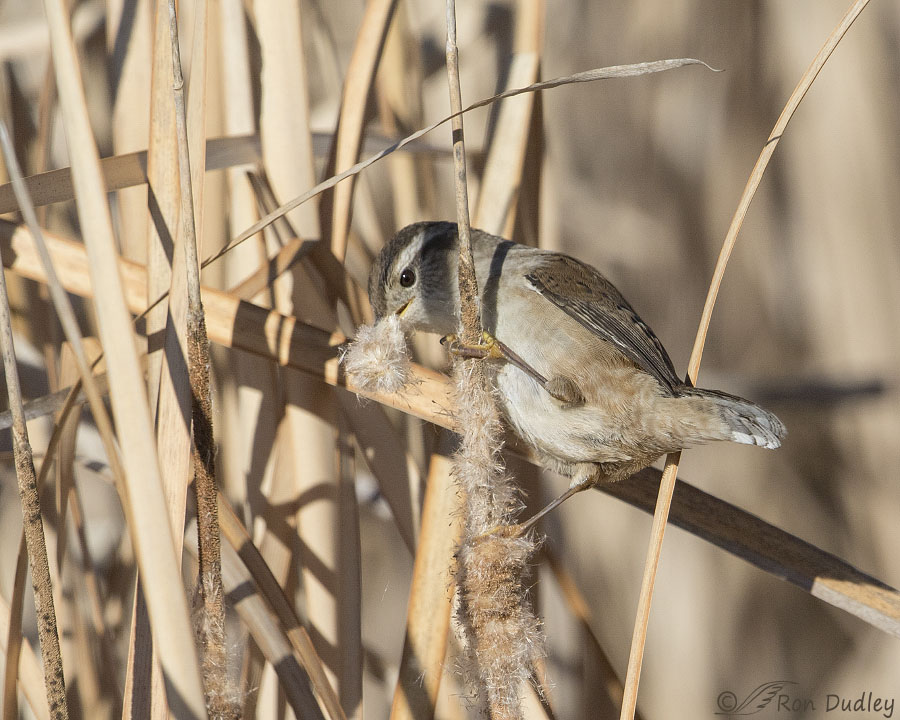
1/4000, f/6.3, ISO 500, Canon 7D Mark II, Canon EF 500mm f/4L IS II USM + EF 1.4 III Extender, not baited, set up or called in
As I said he usually preferred wet cattail leaves but occasionally he collected dry cattail fluff instead. He presumably used the fluff to line the interior nest cup so he wouldn’t want it to be wet and matted down. Marsh Wrens also use down feathers for this purpose.
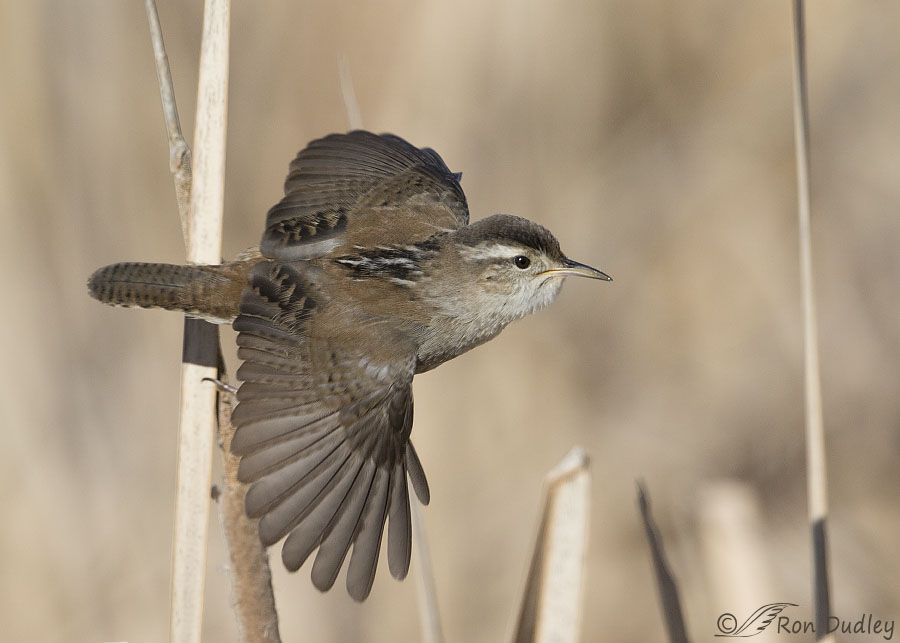
1/5000, f/6.3, ISO 500, Canon 7D Mark II, Canon EF 500mm f/4L IS II USM + EF 1.4 III Extender, not baited, set up or called in
I was constantly trying to get flight shots and this is the only one I would really call a success. Have I mentioned previously that Marsh Wrens are fast!
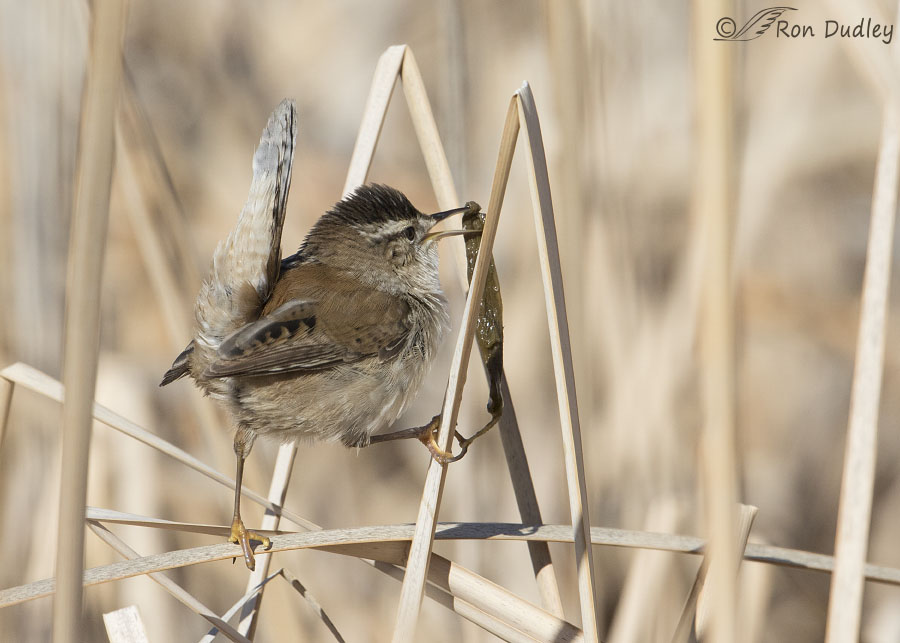
1/2500, f/6.3, ISO 500, Canon 7D Mark II, Canon EF 500mm f/4L IS II USM + EF 1.4 III Extender, not baited, set up or called in
He was definitely picky about his choice of sopping-wet cattail leaves for the nest. After picking this one up at the water’s edge he landed here and manipulated it with his bill for a few seconds but then he…
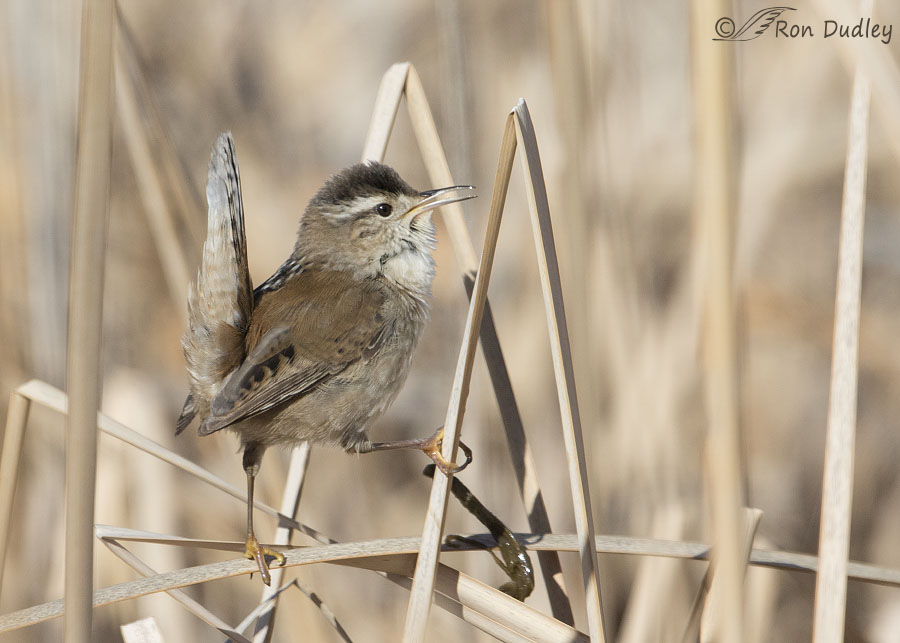
1/2500, f/6.3, ISO 500, Canon 7D Mark II, Canon EF 500mm f/4L IS II USM + EF 1.4 III Extender, not baited, set up or called in
rejected and dropped it. Here we see it still falling beneath his right foot.
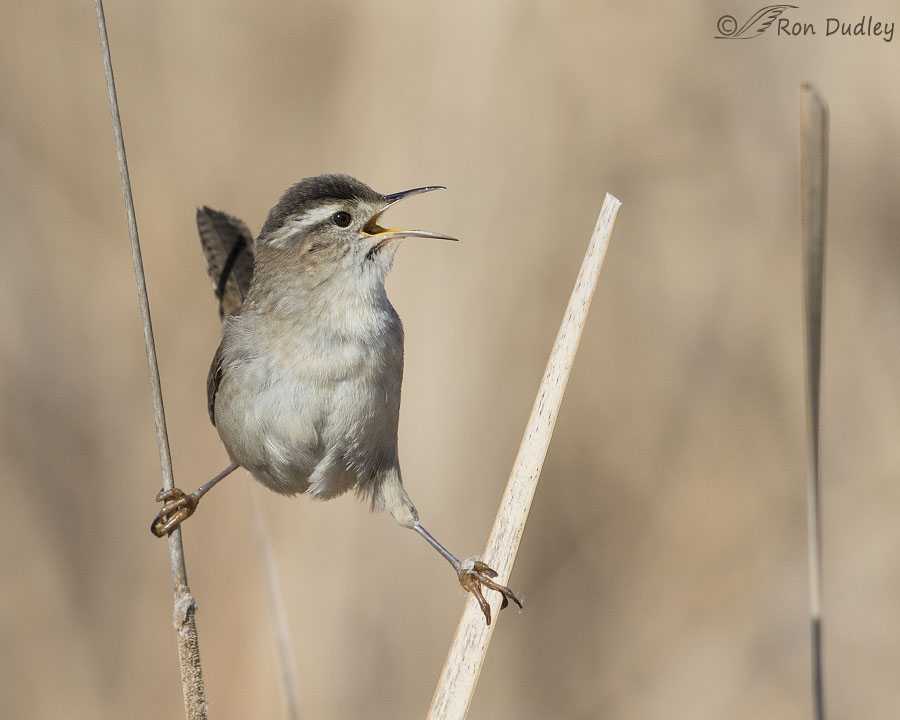
1/4000, f/6.3, ISO 500, Canon 7D Mark II, Canon EF 500mm f/4L IS II USM + EF 1.4 III Extender, not baited, set up or called in
Toward the end of my time with him he took a break from construction and performed a raucous little melody in a classic spread-eagle pose for wrens.
Here’s some fascinating facts about Marsh Wren nests and their construction:
- In one study males built an average of 13.7 dummy nests and spent 9.3 hours constructing each one (they can have up to 21 nests).
- Eventually the female will choose one of the nests for egg-brooding or begin constructing one herself if his construction doesn’t meet her high standards (boy do I remember being in a similar situation a time or two. Or 40.)
- Three dummy nests that were carefully dissected by researchers contained an average 476 strips of cattail leaves and 100 pieces of down.
- It’s thought that males produce many dummy nests for a variety of reasons including: 1. Wren nests are complex and building them takes practice and experience. 2. Extra nests serve as shelter for newly fledged young and for resident adults during winter. 3. If a nest is destroyed during egg-laying females can continue to lay in another nest, 4. The number of nests may serve as an indicator of male vigor or the quality of his territory, or both. 5. Dummy nests may serve as decoys for predators.
- Some nests are constructed partially of snake skin.
I wish I could have watched this male as he was actually weaving the nest but it was so deeply buried in a small clump of cattails I couldn’t even get a glimpse of it. I should have thought to photograph that clump with a wider angle lens for documentary purposes but I guess I was too involved in trying to capture this busy little guy.
Maybe next time.
Ron


Beautiful series, lovely photos as usual. On my long drive to Kearney, Ne., I listened to Richard Dawkins The Selfish Gene. I don’t know if you have read it, but it talks about the amount of energy spent to reproduce, for a small bird that is a lot of spent energy!
I have read the House Wren builds several nest also. He finds his “Bride” and she picks the one she wants and then lines that one with feathersand or soft material.
I have read that the House Wren will build several nest also and find his “Bride” and she will pick the one she wants.
Fantastic Photos!! Loved looking at all of them. I definitely have a soft spot for wrens and you really captured this one. Great post!
Thank you, Joanne.
Loved this series.
But have to say that I am disturbed at the ‘giving the female extra testosterone’ bit. Why? What scientific purpose could that achieve? Sigh.
And then I went back to marvelling at the antics of this industrious little guy.
I don’t know the specific answer to your question, EC. But I did address my thoughts on the subject in my reply to Sallie, below.
Thank you. Information for informations sake is something which continues to worry me though.
Oh, I agree with you there, EC. An example is bird banding. Some of it absolutely benefits birds far more than any potential harm done to them BUT a significant amount of banding is done largely because it’s “sexy” or to allow researchers to pad their resume’s. IMO banding should only be done for well designed study projects that have specific objectives that benefit birds, not people.
The study of complex communication skills and the physiological mechanisms that control it could have many useful applications in medicine. On the other hand, leave the Wrens alone. Such research is unlikely to benefit them.
Wonderful shots of super perky, saucy little bird, all kinds of new and intersting info…a real winner all around! I wonder if other birds, critters, use those extra nest…whole or parts of….had no idea they made so many…learn something new and interesting in EVERY posting! Amazing! You’re still teaching, I’m still learning…..
Thanks very much, Patty. I have no idea if other species use the extra nests but I didn’t notice anything in the literature about it while I was researching this post.
Very informative and beautifully illustrated, Ron. I like both flight shots but especially the one which froze him coming towards you with nesting material. They are not reliably present during winter in our local south Florida wetlands. Have not seen one here this season, and I think they are already heading north.
Thank you, Ken.
What a fantastic series, Ron! I only get to see Marsh Wrens in migration so I really enjoyed the nesting-building information. Spectacular shots of that little skulker!
Thanks, Diane. Some of our Marsh Wrens migrate and others are resident year round.
These are splendid. This is exactly the sort of wildlife photography I like best – the animal in its home, doing what it does. Your work on these is excellent. I admire hell out of this stuff. I know what it takes. Thank you!
Martha, I have to tell you how much your comment meant to me. It came in on my phone while I was in the field this morning trying to get some nice photos and I was having absolutely no success so I was feeling quite discouraged. Your comment picked me up enough that a few minutes later I want back and read it again. Thanks for that little pick-me-up!
Ron: A big thank you! The pictures and text are beautiful and fascinating; just a fun-to-read and beautiful-to-see post.
Dick
I’m glad you enjoyed it, Richard.
Wonderful! Both photo’s and information on the Marsh Wrens! 🙂 I’m not familiar with them – just “house wrens” that are equally ambitious tho I haven’t noticed multiple nests and these are usually in the open. Such fun birds! 🙂
Thank you, Judy.
So rich a blog this AM. Avian OCD in full spate. It is curious to me that female birds don’t seem to have the mechanics for song, or some of them don’t. I think among the Black-headed Grosbeaks here that make summer so glorious with their music the females can and do sing, and quite complex songs, but they sing for different reasons from the males. I guess. I also guess Marsh Wren transgendering doesn’t work too well and kinda wish the researchers hadn’t messed with them. Life for a little wren is too short to fritter.
I agree…leave nature alone…what right do you think you have to play around with other’s lives??????
Sallie, I can understand that reaction to studies like that one. On the other hand if we didn’t understand the biology and physiology of birds we often wouldn’t know how help them in their survival in certain situations. All knowledge about such things is potentially valuable to the birds IMO. Thank you.
Outstanding photos Ron and an education for those of us not familiar with Marsh Wrens. I’m curious – approximately how far away were you when you took these. Best wishes for a good Easter weekend.
Everett Sanborn, Prescott AZ
Everett, A wild guess would be about 25′.
Fascinating–“dummy nest” is a new concept to me, and I can understand , thanks to your explanations, just how useful they can be……good thing he’s so motivated !
Good to know my explanation was helpful in your understanding, Kris. Thanks.
What a great series of photos…and what a tiny bundle of energy! -Joel
Thank you, Joel.
I’m still slightly stuck on the fact that there was a study done that involved giving captive female Marsh Wrens supplemental testosterone. 🙂 Great photography and very interesting as always!
Yes, that’s an interesting little tidbit, isn’t it, David!
Love these photos of the Marsh Wren. I have read that a male Carolina Wren begins about 3 nests then their mate chooses 1 and that is the nest he finishes. Wrens are so smart and the songs emitting from those tiny bodies are amazing. I always am delighted by your posts. I learn so much looking at your stunning photos and reading your comments. Thank you!
It’s quite interesting how the behaviors of our various wren species differ so much, Melanie. And are also similar in some ways.
Fantastic series on and fascinating facts! Thanks so much for sharing!
Charlotte
Thanks, Charlotte.